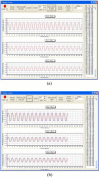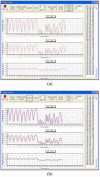Evaluation of mechanical accuracy for couch-based tracking system (CBTS)
- PMID: 23149775
- PMCID: PMC5718538
- DOI: 10.1120/jacmp.v13i6.3818
Evaluation of mechanical accuracy for couch-based tracking system (CBTS)
Abstract
This study evaluated the mechanical accuracy of an in-house-developed couch-based tracking system (CBTS) according to respiration data. The overall delay time of the CBTS was calculated, and the accuracy, reproducibility, and loading effect of the CBTS were evaluated according to the sinusoidal waveform and various respiratory motion data of real patients with and without a volunteer weighing 75kg. The root mean square (rms) error of the accuracy, the reproducibility, and the sagging measurements were calculated for the three axes (X, Y, and Z directions) of the CBTS. The overall delay time of the CBTS was 0.251 sec. The accuracy and reproducibility in the Z direction in real patient data were poor, as indicated by high rms errors. The results of the loading effect were within 1.0 mm in all directions. This novel CBTS has the potential for clinical application for tumor tracking in radiation therapy.
Figures






Similar articles
-
An experimentally validated couch and MLC tracking simulator used to investigate hybrid couch-MLC tracking.Med Phys. 2017 Mar;44(3):798-809. doi: 10.1002/mp.12104. Med Phys. 2017. PMID: 28079260
-
Electromagnetic guided couch and multileaf collimator tracking on a TrueBeam accelerator.Med Phys. 2016 May;43(5):2387. doi: 10.1118/1.4946815. Med Phys. 2016. PMID: 27147350
-
Implementation and experimental results of 4D tumor tracking using robotic couch.Med Phys. 2012 Nov;39(11):6957-67. doi: 10.1118/1.4758064. Med Phys. 2012. PMID: 23127089 Free PMC article.
-
Patient motion tracking for non-isocentric and non-coplanar treatments via fixed frame-of-reference 3D camera.J Appl Clin Med Phys. 2020 Mar;21(3):162-166. doi: 10.1002/acm2.12842. Epub 2020 Feb 28. J Appl Clin Med Phys. 2020. PMID: 32107845 Free PMC article.
-
Development and evaluation of a prototype tracking system using the treatment couch.Med Phys. 2014 Feb;41(2):021720. doi: 10.1118/1.4862077. Med Phys. 2014. PMID: 24506611
Cited by
-
Fast Fourier transform combined with phase leading compensator for respiratory motion compensation system.Quant Imaging Med Surg. 2020 May;10(5):907-920. doi: 10.21037/qims.2020.03.19. Quant Imaging Med Surg. 2020. PMID: 32489916 Free PMC article.
-
Four-dimensional computed tomography based respiratory-gated radiotherapy with respiratory guidance system: analysis of respiratory signals and dosimetric comparison.Biomed Res Int. 2014;2014:306021. doi: 10.1155/2014/306021. Epub 2014 Sep 7. Biomed Res Int. 2014. PMID: 25276775 Free PMC article.
References
-
- Langen KM and Jones DT. Organ motion and its management. Int J Radiat Oncol Biol Phys. 2001;50(1):265–78. - PubMed
-
- Xing L, Thorndyke B, Schreibmann E, et al. Overview of image‐guided radiation therapy. Med Dosim. 2006;31(2):91–112. - PubMed
-
- Keall PJ, Mageras GS, Balter JM, et al. The management of respiratory motion in radiation oncology Report of AAPM Task Group 76. Med Phys. 2006;33(10):3874–900. - PubMed
-
- Hanley J, Debois MM, Mah D, et al. Deep inspiration breath‐hold technique for lung tumors: the potential value of target immobilization and reduced lung density in dose escalation. Int J Radiat Oncol Biol Phys. 1999;45(3):603–11. - PubMed
-
- Rosenzweig KE, Hanley J, Mah D, et al. The deep inspiration breath‐hold technique in the treatment of inoperable non‐small‐cell lung cancer. Int J Radiat Oncol Biol Phys. 2000;48(1):81–87. - PubMed
Publication types
MeSH terms
LinkOut - more resources
Full Text Sources
Other Literature Sources

